Run15 pAu 200GeV TOF3*VPDMB-30 trigger
Motivation:
run 15 p+Au 200GeV
run number:
16125053
Production: fastoffline
Check the trigger TOF3*VPDMB-30 (trigger id = 59), compared with VPDMB-30 (trigger id = 500904).
TOF3: tofmult>100
bandwidth: 25 Hz after prescale 2.
For physics motiviation:
https://drupal.star.bnl.gov/STAR/system/files/HighMultiTrig_150313YL.pdf
For run15 pp 200 GeV TOFMult3 QA plots:
drupal.star.bnl.gov/STAR/blog/yili/run15-pp-200gev-tof3vpd-trigger
For run12 pp 200 GeV MinBias and TOF high multiplicity QA plots:
https://drupal.star.bnl.gov/STAR/system/files/HighMultiTrig_150324YL.pdf
QA plot:
Part I: High-mult vs MB
1. tofmult (trigger) for High-mult vs MB:
.gif)
.gif)
Note: for high-mult data, number of events drops rapidly until TOFMult ~ 150.
When TOFMult > 150, the drop is quite smooth.
For high-mult trigger data: TOFmult > 150: 77% of total trigger events.
2. Vz:

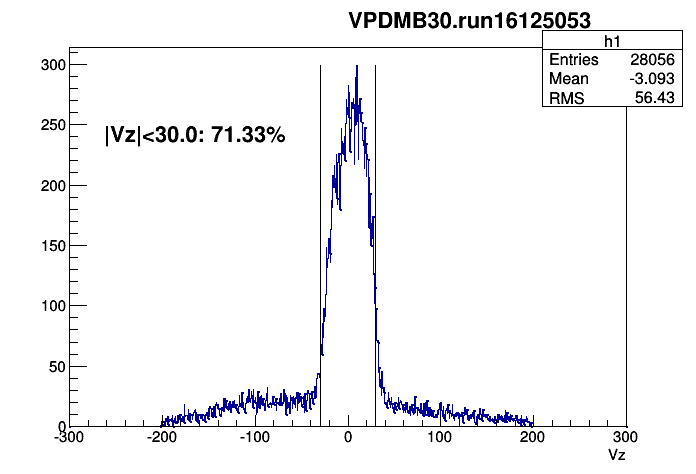
Note: High-mult data have few events at center of the TPC.
The peak at Vz = 140 cm, (beam pipe interaction?) Also seen on slide 6 at Kathryn Meehan's nuclear.ucdavis.edu/~kmeehan/protected/Update-Apr-22-15.pdf (the two black lines are to guide eyes for +- 30cm)
For the variables below, we will discuss the events w/o vs with |Vz| < 30 cm cut. So there will be four plots for each variables in most cases.
3. Number Of Primary Tracks in TPC
a. No Vz cut
.gif)
.gif)
b. |Vz| < 30 cm cut
.gif)
.gif)
Note: from this small MB sample, 80 tracks give 0.01%.
|Vz|<30 cm increases high-mult efficiency by x 5.
With |Vz|<30 cm, the trigger increases the high-mult events by x 100.
Without Vz, increases by x 20
4. Number of Primary Vertices
No Vz cut:
.gif)
.gif)
Note: Do data really have such large pileup for both high-mult and MB?
5. Number of Primary Tracks vs Tofmult (trigger)
a. No Vz cut
.gif)
.gif)
b. |Vz| < 30 cm cut
.gif)
.gif)
Note: High-mult data have large noise when Tofmult trigger > 150
6. Number of Primary Tracks / Global Tracks # vs Tofmult (trigger)
a. No Vz cut
.gif)
.gif)
b. |Vz| < 30 cm cut
.gif)
.gif)
Note: High-mult data have large pileup (small Primary/Global ratio) when Tofmult trigger > 150
7. Vz vs Tofmult (trigger)
No Vz cut


8. Vr comparison (for the Vz peak at 140 cm, from beam pipe?)

.gif) |
.gif) |
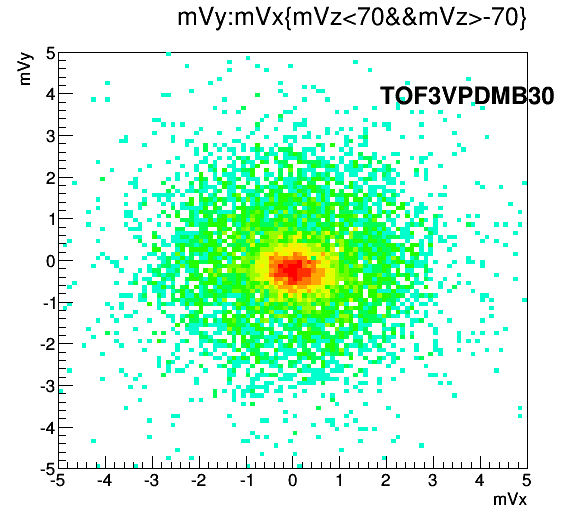 |
Part II: High-mult threshold:
Compare 100<TofMult<110, 100<TofMult<150, TofMult >150
1. Vz:
2. Number of Primary Tracks:
Note: For last plot, the 8 entries are all from TofMult > 200. No entry in 150<TofMult<200.
Conclusion:
For Tofmult > 150, trigger on large noise.
Strategy:
1. if we can set uplimit for tofmult trigger:
Only trigger on events with 80 < tofmult < 150.
If the bandwidth is too large, we can do 85-150. If still too large, add prescale
2. If we can not set uplimit.
Set tofmult > 80 and use prescale.
Discussions:
1. Whether the default vertex is the one triggers.
Pick up the vertex with largest BTOFMatch for high-mult data (high-mult is high TOF Multiplicity trigger). So this one should be the closer to the 'real' trigger vertex.
How does the largest BTOFMatch vertex (the 'real' trigger vertex) match to the default Vz:
| High-mult | MB |
Note: For left plot (high-mult data), there is a line on the diagonal for default Vz is the 'real' one. But there is also a lot of case when 'real' vertex is at 100 < Vz < 200 cm, the default vz is independent of 'real' vz.
Right plot is for MB data (largest BTOFMatch is not the good Vertex this case).
Vz distribution by number:
| default Vertex | Vertex with largest BTOFMatch |
.gif) |
.gif) |
Note: The peak at 140 cm increases from 1000 to 3000 when selecting on largest BTOFMatch vertex (the 'real' triggerred vertex )
Number of primary tracks:
| default Vertex | Vertex with largest BTOFMatch |
.gif) |
.gif) |
Note: Mean of number of primary tracks increases (This increase is almost guaranteed since BTOFMatch is the number of primary tracks matched to TOF hits which is kind of selecting itself).
The distribution shape also changes.
Compare number of primary tracks distribution for vertex with |Vz| < 100 cm and Vz > 100 cm (for the peak at 140 cm).
| default Vertex | Vertex with largest BTOFMatch | |
| |Vz|<100 cm |  |
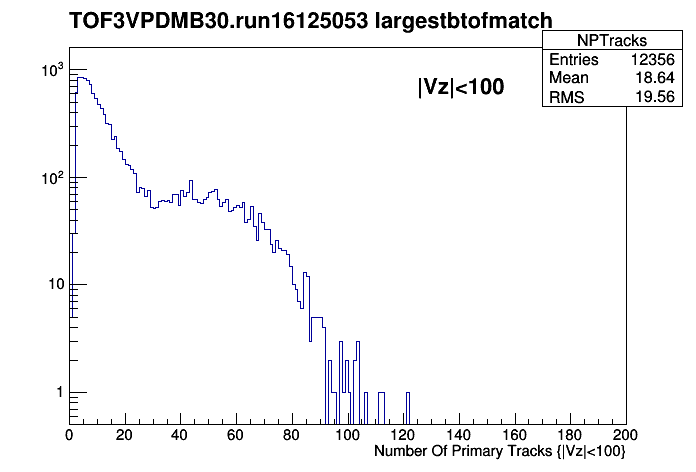 |
| Vz > 100 cm |  |
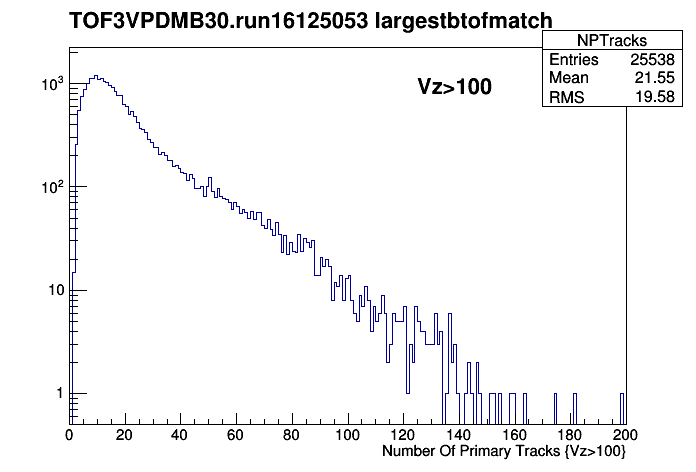 |
Note:
1) For |Vz| < 100 cm, the 'real' vertex (largest BTOFMatch) has larger number of primary tracks. This suggests for the good trigger event, the trigger efficiency is actually better. The default vertex finding may not be the best for the high-multiplicity evet.
2) For Vz > 100 cm, those events probably hit beam pipe ~ 140 cm, give large number of tracks in TPC and hits in TOF such that they fire the high-multplicity trigger. Since they are not centered at TPC, the default Vz doesn't not pick the collision and instead reconstruct another collision happening at the same time.
What's why the largest BTOFMatch vertex has more events at peak 140 cm than the default one, and the default vertex at Vz > 100 cm has smaller number of tracks than the BTOFMatch and it is also smaller than |Vz| < 100 cm
Those events are not what we want.
Question: There is |vpdvz| < 30 cm requirement in the trigger definition. Why doesn't it work?
2. vpd performance on Vz requirement.
vpdVz information is uncalibrated for fast offline (exact number may not be realiable). vpdVz is independent of primary vertex.
| High-mult | MB |
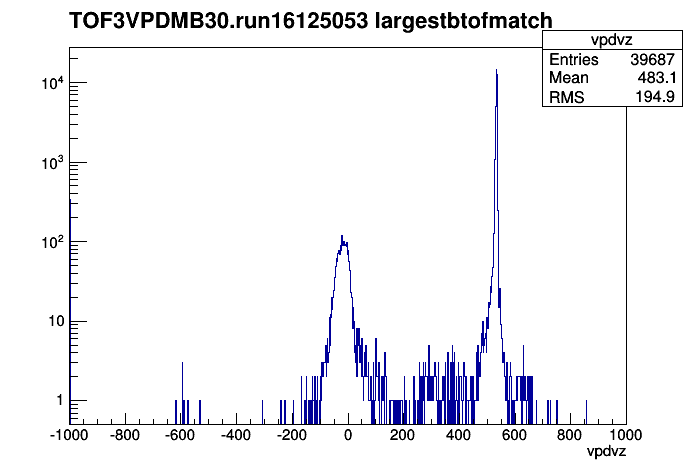 |
 |
Note: From high-mult, large peak at vpdvz 550 cm, which is 100 times the events at center 0 cm.
The peak is also seen in MB, but is much smaller.
Question: Does the vpdvz number not make sense at all? Or does it work for |vpdVz| < 30 cm cut?
More on the vpdvz peak at 550 cm:
TOFMult (trigger) and vdpvz:
| vpdvz < 200 cm | vpdvz > 200 cm |
 |
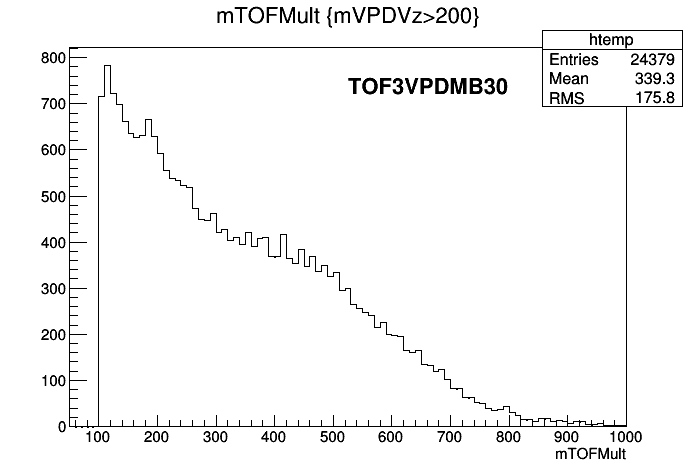 |
Note: Those vpdvz peaked at 550 cm (right plot) give lots of large TOF mult .
if this vpdvz value is true, those event with tofmult trigger > 200 is not what we want.
vpdvz vs vz (the largest BTOFMatch one)
Number of primary tracks (associated with largest BTOFMatch vertex) vs TOFmult trigger:
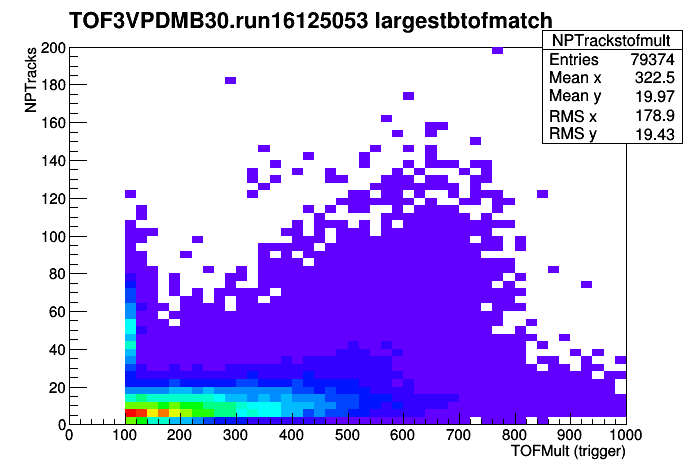
break down into vpdVz:


Left plot (vpdvz center at 0 cm) is good, High TOF mult select on large Number of primary tracks.
Right plot (vpdvz peaked around 550 cm) has two components: one at small number of tracks for all tofmult trigger, the other one number of tracks rising with tof mutl.
For vpdvz peaked around 550 cm, break down into vz:

So the component showing rising trend in number of tracks and tofmult trigger for vpdvz peaked at 550 cm are from those event vz peaked at 140 cm (the one hits beam pipe)
Another small note:
From the previous study using neutron tag d+Au data, 90 tracks will be top 0.01%. The fastoffline shows 80 tracks is top 0.01% (small smaple though). The VPDMB-30 rate is 22,000 Hz. Then, the 0.01% top event will be 20 Hz. The TOF3VPDMB-30 with 100 hits in TOF seen is actually 50 Hz (after prescale, we are taking 20 Hz), which is more than 30 Hz larger. From the above result and discussion, after tofmult trigger > 150, there is large noise.
- yili's blog
- Login or register to post comments
